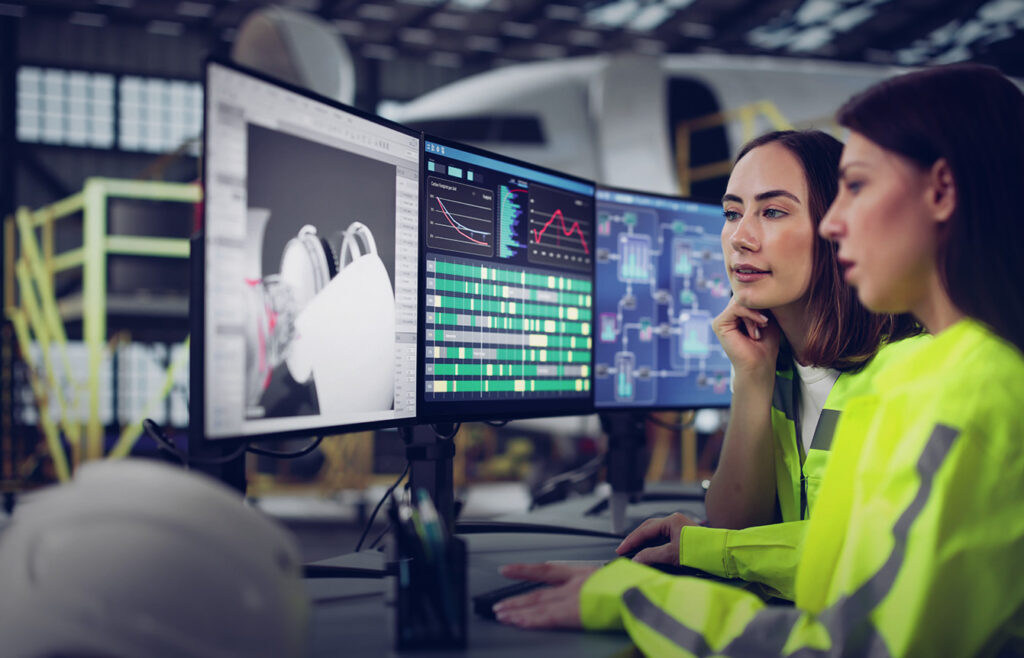How AI Is Helping Improve Quality, Reduce Defects, and Increase Efficiency for Parts & Assemblies Fabrication
High-precision manufacturing sectors like aerospace and defense have long relied on the latest technologies to ensure quality and performance — essential factors for mission-critical parts and assemblies. Given these targets, it’s no surprise AI has found its way onto the manufacturing floor. Using AI to drive data analytics in aerospace and defense manufacturing can improve product quality, streamline production, reduce defects, and ensure traceability across complex systems.
Incorporating AI into advanced manufacturing isn’t about replacing human expertise but amplifying it. In this article, we’ll explain how AI-driven data analytics are transforming aerospace and defense manufacturing, the benefits and limitations of this evolving technology, and the guardrails that need to be in place for responsible, effective integration.

Why AI in Aerospace and Defense, and Why Now?
AI offers a unique benefit to data analytics in aerospace and defense manufacturing.
Increasingly complex geometries, tight tolerances, and rigorous compliance requirements generate large volumes of data across design, machining, inspection, assembly, and fabrication processes. AI systems—especially those using machine learning—can rapidly analyze this data, quickly identifying patterns and anomalies that would be difficult or even impossible to detect manually.
Supply chain efficiency and reliability is growing more critical as defense programs evolve, and AI offers a path to smarter, data-driven decisions throughout the product lifecycle.

Applications of AI-Powered Data Analytics in Aerospace & Defense Manufacturing
- Defect Detection and Quality Assurance
AI systems can analyze past and real-time production data to detect the root causes of quality issues before they result in costly rework or nonconformance. By identifying correlations between process variables and defect rates, manufacturers can proactively adjust their machines to prevent defects from occurring in the first place.
For example, a machine learning algorithm might detect that certain tool wear profiles are precursors to surface defects in a high-speed milled titanium component, triggering preventive maintenance or adaptive tool pathing.
- Process Optimization and Efficiency
Data-driven AI models can help fine-tune production parameters for greater throughput and reduced cycle time. For example, by continuously monitoring sensor data from CNC machines, AI models can recommend better feed rates, cutting speeds, or coolant usage, helping to balance speed and quality in real time.
These optimizations compound across programs, leading to greater shop floor efficiency without compromising precision.
- Improved Scheduling and Resource Allocation
In defense manufacturing, managing capacity across a mix of urgent, high-complexity programs is a constant challenge. AI can enhance production planning by analyzing capacity constraints, order priorities, part geometries, and setup requirements to optimize scheduling and improve on-time delivery while minimizing downtime and resource waste.
- Enhanced Traceability and Regulatory Compliance
AI-powered systems can streamline data collection and documentation so manufacturers get detailed digital records for every part and assembly. These records help support quality audits and customer compliance requirements while improving visibility and accountability throughout the supply chain.
AI can also flag inconsistencies in production data, indicating possible risks or issues and potentially protecting against cyber attacks and other threats to data integrity.

How Aerospace and Defense Manufacturers Can Benefit from AI Integration
Improved Products: AI can provide early defect detection to help improve quality assurance.
Lower Rework Rates: Proactive correction of process deviations using AI models helps lower scrap and rework rates.
Increased Uptime: Predictive maintenance powered by AI-driven sensor data analytics keeps equipment on and lines moving.
Improved Decision-Making: Through rapid analysis of large amounts of data, AI can identify trends and outliers, influencing decisions and outcomes.
Smarter Workforce Utilization: Using AI to perform tedious data analysis frees up operators and engineers to focus on higher-value tasks.
While the benefits look great on paper, integrating AI into aerospace and defense manufacturing doesn’t come without challenges. Here are a few issues AI can present that you should consider before onboarding AI-driven data analysis:
Data Quality and Availability: AI models are only as good as the data they’re trained on. Inconsistent or incomplete datasets can lead to inaccurate predictions or outcomes and gaps in important data sets.
Legacy System Integration: It isn’t uncommon for the manufacturing environment to include legacy equipment, and there are challenges with leveraging these systems to enable data capture.
Talent and Training Acquisition: Using AI effectively requires skilled employees who understand how manufacturing and data science work together. Training existing workers or hiring new is essential..
Cybersecurity and IP Protection: Onboarding any digitized technology opens your environment up to cybersecurity risks; you should be prepared to secure your AI systems against attacks, especially in aerospace and defense environments.
The Human Touch: AI is not a replacement for humans, and although it helps streamline human work, it should always be used alongside experienced (human) engineers. Be sure to put rules and guidelines in place to ensure critical decisions remain in human hands.

Use AI Responsibly in Your Manufacturing Environment
There are many benefits to using AI for data analytics in aerospace and defense manufacturing environments as long as it is implemented and used responsibly.
Here are a few quick tips for make it happen:
- Start with a plan: After onboarding your AI model, start with pilot projects focused on a specific process or problem.
- Invest in data infrastructure: Put sensors, connectivity, and data governance in place to support reliable analytics.
- Collaborate across teams: Your manufacturing, engineering, QC/QA, and IT teams should be involved early and often.
- Prioritize clarity: Choose AI models that offer clear, interpretable outputs—especially for regulated or safety-critical applications.
- Build feedback loops: Be sure to routinely validate model outputs against real-world outcomes to refine performance.
AI-powered data analytics is a present-day tool reshaping how aerospace and defense manufacturers deliver precision, reliability, and performance.
As AI adoption grows across the aerospace and defense industries, success will come not just from adopting the technology—but from applying it thoughtfully, responsibly, and in alignment with the uncompromising standards of aerospace and defense manufacturing.

